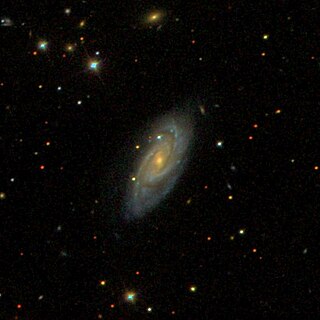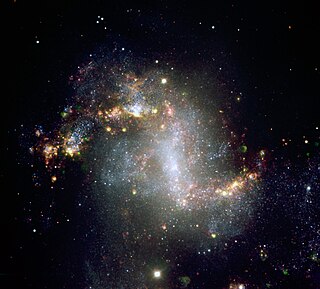
The Hubble sequence is a morphological classification scheme for galaxies published by Edwin Hubble in 1926. It is often colloquially known as the Hubble tuning-fork diagram because the shape in which it is traditionally represented resembles a tuning fork. It was invented by John Henry Reynolds and Sir James Jeans.

The New General Catalogue of Nebulae and Clusters of Stars is an astronomical catalogue of deep-sky objects compiled by John Louis Emil Dreyer in 1888. The NGC contains 7,840 objects, including galaxies, star clusters and emission nebulae. Dreyer published two supplements to the NGC in 1895 and 1908, known as the Index Catalogues, describing a further 5,386 astronomical objects. Thousands of these objects are best known by their NGC or IC numbers, which remain in widespread use.

Messier 100 is a grand design intermediate spiral galaxy in the southern part of the mildly northern Coma Berenices. It is one of the brightest and largest galaxies in the Virgo Cluster and is approximately 55 million light-years from our galaxy, its diameter being 107,000 light years, and being about 60% as large. It was discovered by Pierre Méchain in 1781 and 29 days later seen again and entered by Charles Messier in his catalogue "of nebulae and star clusters". It was one of the first spiral galaxies to be discovered, and was listed as one of fourteen spiral nebulae by Lord William Parsons of Rosse in 1850. NGC 4323 and NGC 4328 are satellite galaxies of M100; the former is connected with it by a bridge of luminous matter.

Seyfert galaxies are one of the two largest groups of active galaxies, along with quasar host galaxies. They have quasar-like nuclei with very high surface brightnesses whose spectra reveal strong, high-ionisation emission lines, but unlike quasars, their host galaxies are clearly detectable.

Messier 107 or M107, also known as NGC 6171 or the Crucifix Cluster, is a very loose globular cluster in a very mildly southern part of the sky close to the equator in Ophiuchus, and is the last such object in the Messier Catalogue.

NGC 3 is a lenticular galaxy with the morphological type of S0, located in the constellation of Pisces. Other sources classify NGC 3 as a barred spiral galaxy as a type of SBa. It was discovered on November 29, 1864, by Albert Marth.

NGC 1365, also known as the Fornax Propeller Galaxy or the Great Barred Spiral Galaxy, is a double-barred spiral galaxy about 56 million light-years away in the constellation Fornax. It was discovered on 2 September 1826 by Scottish astronomer James Dunlop.

NGC 7217 is an unbarred spiral galaxy in the constellation Pegasus.

NGC 5474 is a peculiar dwarf galaxy in the constellation Ursa Major. It is one of several companion galaxies of the Pinwheel Galaxy (M101), a grand-design spiral galaxy. Among the Pinwheel Galaxy's companions, this galaxy is the closest to the Pinwheel Galaxy itself. The gravitational interaction between NGC 5474 and the Pinwheel Galaxy has strongly distorted the former. As a result, the disk is offset relative to the nucleus. The star formation in this galaxy is also offset from the nucleus. NGC 5474 shows some signs of a spiral structure. As a result, this galaxy is often classified as a dwarf spiral galaxy, a relatively rare group of dwarf galaxies.

NGC 21 is a spiral galaxy in the Andromeda constellation. It was discovered by German-British astronomer William Herschel on 26 November 1790. Lewis Swift observed it again in 1885, leading to its double listing in the New General Catalogue.

NGC 1313 is a field galaxy and an irregular galaxy discovered by the Scottish astronomer James Dunlop on 27 September 1826. It has a diameter of about 50,000 light-years, or about half the size of the Milky Way.

NGC 2506 is a mildly-elongated open cluster of stars in the equatorial constellation of Monoceros, located at a distance of 12.7 kly from the Sun near the Galactic anti-center. It was discovered by William Herschel in 1791. The cluster lies around 10,000 ly from the Galactic Center and about 1,600 ly above the Galactic plane. It is of intermediate age, estimated at around two billion years. The cluster has an angular radius of 12′ and a core radius of 4.8′.

NGC 43 is a lenticular galaxy in the Andromeda constellation. It has a diameter of approximately 27 kiloparsecs and was discovered by John Herschel in 1827.

NGC 80 is a lenticular galaxy located in the constellation Andromeda. It is currently interacting with two other barred spiral galaxies NGC 47 and NGC 68, and was discovered on August 17, 1828 by John Herschel.

NGC 6886 is a planetary nebula in the constellation Sagitta. It was discovered by Ralph Copeland on September 17, 1884. It is 4.6 ± 1.0 kiloparsec (15.0 ± 3.3 kly) distant from Earth, and is composed of a hot central post-AGB star that has 55% of the Sun's mass yet 2700 ± 850 its luminosity, with a surface temperature of 142,000 K. The planetary nebula is thought to have been expanding for between 1280 and 1600 years.

NGC 1792 is a spiral galaxy located in the southern Columba constellation. It was discovered by Scottish astronomer James Dunlop on October 4, 1826. This galaxy is located at a distance of about 36.4 million light-years and is receding from the Milky Way with a heliocentric radial velocity of 1,208 km/s. NGC 1792 is a member of the NGC 1808 cluster of galaxies.

NGC 4636 is an elliptical galaxy located in the constellation Virgo. It is a member of the NGC 4753 Group of galaxies, which is a member of the Virgo II Groups, a series of galaxies and galaxy clusters strung out from the southern edge of the Virgo Supercluster. It is located at a distance of about 55 million light years from Earth, which, given its apparent dimensions, means that NGC 4636 is about 105,000 light years across.

NGC 5846 is an elliptical galaxy located in the constellation Virgo. It is located at a distance of circa 90 million light years from Earth, which, given its apparent dimensions, means that NGC 5846 is about 110,000 light years across. It was discovered by William Herschel on February 24, 1786. It lies near 110 Virginis and is part of the Herschel 400 Catalogue. It is a member of the NGC 5846 Group of galaxies, itself one of the Virgo III Groups strung out to the east of the Virgo Supercluster of galaxies.

NGC 3665 is a lenticular galaxy located in the constellation Ursa Major. It is located at a distance of circa 85 million light-years from Earth, which, given its apparent dimensions, means that NGC 3665 is about 85,000 light years across. It was discovered by William Herschel on March 23, 1789.



















